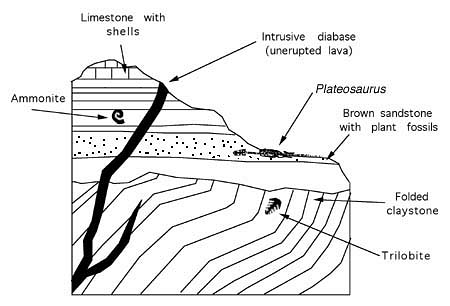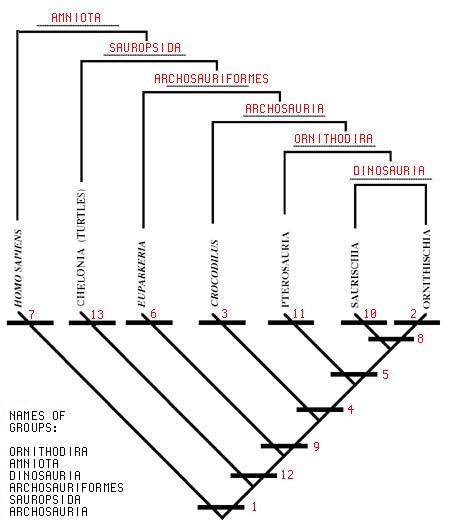
I. TIME SCALE - you will fill in a skeleton time scale that you will need to fill out
II. MULTIPLE CHOICE
1. William Smith worked out:
a) the principle of superposition2. What are some of the main regions that have produced Late Triassic age reptile remains.
b) the principle of biotic succession
c) the Ornithischia and the Saurischia
d) the principle of cross-cutting relationships
a) the Moenkopi and the Karoo3. Carbon dioxide (CO2) is:
b) the Morison and Solonhofen
c) the Chinle, the Atlantic Rift Zone, and the Ischigualasto
d) the Hell Creek, Keuper, and Karoo
a) 28 % of our atmosphere4. A monophyletic group is one in which:
b) limestone
c) < 1 % of our atmosphere
d) produced by photosynthesis
a) some of the members share different common ancestors.5. The Crurotarsi are defined by the following shared derived character.
b) some of the descendants of the common ancestor of the group are not in the group.
c) the common ancestor of the group is not within the group.
d) the common ancestor and all of its descendants are within the group.
a) a mesotarsal ankle joint.III. SHORT ANSWER
b) an ankle with many small bones flexing smoothly at a variety of places.
c) an ankle with a joint between the astragalus and calcaneum.
d) a tendentious ankle.
1. Why is the sail-backed animal Dimetrodonfrom the Permian of Texas not a dinosaur?IV. SHORT ESSAY
1) It is a synapsid and therefore lacks the shared derived character of the dinosaurs - an open acetabulum. And 2) It is Permian in age and dinosaurs evolved in the Late Triassic.
2. What are the main difference between the Ornithodira and Ornithischia?
1) Ornithodira contain the Ornithischia. And 2) the Ornithischia have the shared derived character of a backward pointing pubis (missing in other ornithodirans as well as the dinosaurian shared derived character of an open acetabulum, missing in the non-dinosaurian ornithodirans.
3. Why is the saurischian triradiate pelvis not a shared derived character that defines the Saurischia?
1) It is primitive at a level below that of the saurichian, perhaps even at the level of the Amniota). And 2) The shared derived character of the saurischia is the in fact the twisted and enlarged digit I (thumb).4. Where would you look for dinosaur fossils and why?
1) Sedimentary, deposits of continetal origin. And 2) rocks of Mesozoic age.
5. How is limestone (=calcium carbonate = CaCO3) related to the greenhouse effect?
1) Limestone is a sink for carbon which comes from the weathering of calcium silicate rocks on the continents by CO2 via carbonic acid. And 2) the more carbon gets buried as limestone, the less CO2 in the atmosphere and the less greenhouse effect and the cooler it gets.
PREPARE A SHORT ESSAY ON ONE OF THE FOLLOWING QUESTIONS:
1. Given the cross-section of rock strata exposed in a canyon wall below,
outline the history of the area, stating the various basic stratigraphic
principles you used and stating the geological periods to which the rock
unit belong. The intrusive diabase give a potassium-argon date of 100 million
years.

The essay should cover the chronology of events as recorded in this cross-section. For example: the oldest strata to be deposited were the folded claystone according to the Principle of Superposition of Steno. Steno's Principle of Principle of Stratal Continuity suggests that they extended far beyond the unconformity that truncates them, and Steno's Principle of Initial Horizontality suggests that they were laid down flat and folded upward into their present attitude. The unconformity between the folded claystone and the overlying flat rocks indicate a period of erosion showing that a long period of time had passed between the deposition of the two set of strata. That follows from James Hutton's Principle of Uniformitarianism. And so on. IT IS CRITICAL TO REMEMBER TO WRITE IN SENTENCES AND PARAGRAPHS, NOT JUST AN OUTLINE - THIS IS AN ESSAY.2. There are two main types of ankles seen in the Archosauriformes that are also shared derived characters for several important groups.
*Other possible topics could include: the carbon cycle; the different
groups of suchians; the different types of skull openings;
Herrerasaurus; tetrapod postures. V. DINOSAURIAN RELATIONSHIPS
FILL OUT THE FOLLOWING CLADOGRAM WITH THE CHARACTERS AND GROUP NAMES LISTED BELOW. PLACE THE NUMBER OF EACH CHARACTER NEXT TO THE NODE IN THE CLADOGRAM WHICH DEFINES THE GROUPS AND PUT THE APPROPRIATE GROUP NAME ABOVE THE DOTTED LINE.

1. Amniotic eggVI. DINOSAURIAN ANATOMY
2. Backwardly pointing pubis
3. Crurotarsal ankle
4. Loss of palatal teeth
5. Mesotarsal ankle
6. No unique derived features
7. One temporal opening low on skull
8. Open acetabulum
9. Skull with antorbital opening and upper and lower temporal openings
10. Twisted and enlarged digit 1 on hand
11. Very elongated wing finger
12. Suorbital fenestrae
13. Hard shell covering body
You will be asked to lable the bones on a drawing of a skeletons much (but not the same as) like that one of Euparkeria you were handed out.